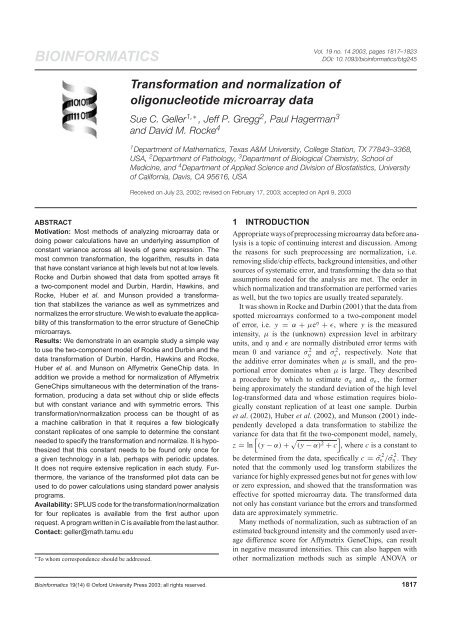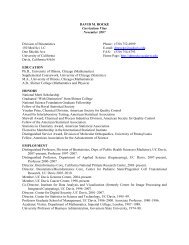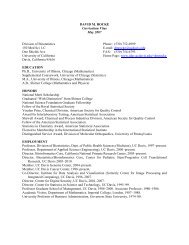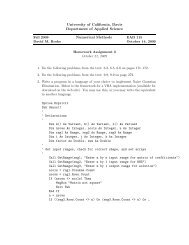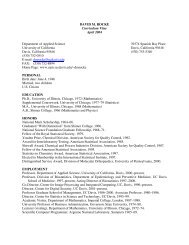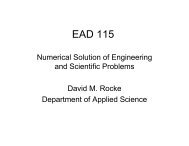Transformation and normalization of oligonucleotide microarray data
Transformation and normalization of oligonucleotide microarray data
Transformation and normalization of oligonucleotide microarray data
Create successful ePaper yourself
Turn your PDF publications into a flip-book with our unique Google optimized e-Paper software.
BIOINFORMATICSVol. 19 no. 14 2003, pages 1817–1823DOI: 10.1093/bioinformatics/btg245<strong>Transformation</strong> <strong>and</strong> <strong>normalization</strong> <strong>of</strong><strong>oligonucleotide</strong> <strong>microarray</strong> <strong>data</strong>Sue C. Geller 1,∗ , Jeff P. Gregg 2 , Paul Hagerman 3<strong>and</strong> David M. Rocke 41 Department <strong>of</strong> Mathematics, Texas A&M University, College Station, TX 77843–3368,USA, 2 Department <strong>of</strong> Pathology, 3 Department <strong>of</strong> Biological Chemistry, School <strong>of</strong>Medicine, <strong>and</strong> 4 Department <strong>of</strong> Applied Science <strong>and</strong> Division <strong>of</strong> Biostatistics, University<strong>of</strong> California, Davis, CA 95616, USAReceived on July 23, 2002; revised on February 17, 2003; accepted on April 9, 2003ABSTRACTMotivation: Most methods <strong>of</strong> analyzing <strong>microarray</strong> <strong>data</strong> ordoing power calculations have an underlying assumption <strong>of</strong>constant variance across all levels <strong>of</strong> gene expression. Themost common transformation, the logarithm, results in <strong>data</strong>that have constant variance at high levels but not at low levels.Rocke <strong>and</strong> Durbin showed that <strong>data</strong> from spotted arrays fita two-component model <strong>and</strong> Durbin, Hardin, Hawkins, <strong>and</strong>Rocke, Huber et al. <strong>and</strong> Munson provided a transformationthat stabilizes the variance as well as symmetrizes <strong>and</strong>normalizes the error structure. We wish to evaluate the applicability<strong>of</strong> this transformation to the error structure <strong>of</strong> GeneChip<strong>microarray</strong>s.Results: We demonstrate in an example study a simple wayto use the two-component model <strong>of</strong> Rocke <strong>and</strong> Durbin <strong>and</strong> the<strong>data</strong> transformation <strong>of</strong> Durbin, Hardin, Hawkins <strong>and</strong> Rocke,Huber et al. <strong>and</strong> Munson on Affymetrix GeneChip <strong>data</strong>. Inaddition we provide a method for <strong>normalization</strong> <strong>of</strong> AffymetrixGeneChips simultaneous with the determination <strong>of</strong> the transformation,producing a <strong>data</strong> set without chip or slide effectsbut with constant variance <strong>and</strong> with symmetric errors. Thistransformation/<strong>normalization</strong> process can be thought <strong>of</strong> asa machine calibration in that it requires a few biologicallyconstant replicates <strong>of</strong> one sample to determine the constantneeded to specify the transformation <strong>and</strong> normalize. It is hypothesizedthat this constant needs to be found only once fora given technology in a lab, perhaps with periodic updates.It does not require extensive replication in each study. Furthermore,the variance <strong>of</strong> the transformed pilot <strong>data</strong> can beused to do power calculations using st<strong>and</strong>ard power analysisprograms.Availability: SPLUS code for the transformation/<strong>normalization</strong>for four replicates is available from the first author uponrequest. A program written in C is available from the last author.Contact: geller@math.tamu.edu∗ To whom correspondence should be addressed.1 INTRODUCTIONAppropriate ways <strong>of</strong> preprocessing <strong>microarray</strong> <strong>data</strong> before analysisis a topic <strong>of</strong> continuing interest <strong>and</strong> discussion. Amongthe reasons for such preprocessing are <strong>normalization</strong>, i.e.removing slide/chip effects, background intensities, <strong>and</strong> othersources <strong>of</strong> systematic error, <strong>and</strong> transforming the <strong>data</strong> so thatassumptions needed for the analysis are met. The order inwhich <strong>normalization</strong> <strong>and</strong> transformation are performed variesas well, but the two topics are usually treated separately.It was shown in Rocke <strong>and</strong> Durbin (2001) that the <strong>data</strong> fromspotted <strong>microarray</strong>s conformed to a two-component model<strong>of</strong> error, i.e. y = α + µe η + ɛ, where y is the measuredintensity, µ is the (unknown) expression level in arbitraryunits, <strong>and</strong> η <strong>and</strong> ɛ are normally distributed error terms withmean 0 <strong>and</strong> variance ση2 <strong>and</strong> σ ɛ 2 , respectively. Note thatthe additive error dominates when µ is small, <strong>and</strong> the proportionalerror dominates when µ is large. They describeda procedure by which to estimate σ η <strong>and</strong> σ ɛ , the formerbeing approximately the st<strong>and</strong>ard deviation <strong>of</strong> the high levellog-transformed <strong>data</strong> <strong>and</strong> whose estimation requires biologicallyconstant replication <strong>of</strong> at least one sample. Durbinet al. (2002), Huber et al. (2002), <strong>and</strong> Munson (2001) independentlydeveloped a <strong>data</strong> transformation to stabilize thevariance [ for <strong>data</strong> that fit the two-component model, namely,z = ln (y − α) + √ ](y − α) 2 + c , where c is a constant tobe determined from the <strong>data</strong>, specifically c = σˆ2 ɛ / σˆ2 η . Theynoted that the commonly used log transform stabilizes thevariance for highly expressed genes but not for genes with lowor zero expression, <strong>and</strong> showed that the transformation waseffective for spotted <strong>microarray</strong> <strong>data</strong>. The transformed <strong>data</strong>not only has constant variance but the errors <strong>and</strong> transformed<strong>data</strong> are approximately symmetric.Many methods <strong>of</strong> <strong>normalization</strong>, such as subtraction <strong>of</strong> anestimated background intensity <strong>and</strong> the commonly used averagedifference score for Affymetrix GeneChips, can resultin negative measured intensities. This can also happen withother <strong>normalization</strong> methods such as simple ANOVA orBioinformatics 19(14) © Oxford University Press 2003; all rights reserved. 1817
S.C.Geller et al.regression techniques, or the program dChip, which usesan iterative procedure with regression <strong>and</strong> outlier detection(http://www.dchip.org; Li <strong>and</strong> Wong, 2001). Thenegative values for intensities (e.g. when MM > PM) causeproblems when the commonly used log transform is applied tothe normalized <strong>data</strong>. Also, if the variance is not constant acrossexpression levels, then the mean chip/slide intensity is not anoptimal measure <strong>of</strong> the overall level <strong>of</strong> a given chip/slide.We will demonstrate that <strong>data</strong> from Affymetrix GeneChipsconform at least approximately to the two-component model<strong>of</strong> error. Then we shall provide a procedure by which to findthe transformation constant c <strong>and</strong> normalize the <strong>data</strong> at thesame time. This simultaneous procedure is necessary underthe assumptions <strong>of</strong> our model. This method avoids many<strong>of</strong> the problems <strong>of</strong> alternative <strong>normalization</strong> <strong>and</strong> transformationmethods. In particular there is no problem with negativeobserved intensities.2 DATAIn order to investigate replicability <strong>and</strong> the appropriateness <strong>of</strong>the two-component model <strong>of</strong> error for <strong>data</strong> from Affymetrixchips, a single lymphoblastoid cell line from one autistic childwas grown in four separate T75 flasks. The cells were splitfrom the same parent flask <strong>and</strong> grown in the same incubator,same shelf, at the same time. Four separate RNA extractionswere performed when the cells were near confluence. cDNAsynthesis <strong>and</strong> in vitro transcription (IVT) labeling were performedon each sample. Each sample was then hybridizedto an Affymetrix Human Genome U95Av2 <strong>oligonucleotide</strong>GeneChip array, which contains 12 625 probe sets, with eachprobe set designed to represent a single human gene. Notethat these are true replicates <strong>of</strong> the whole measurement process,not just machine replicates in which the same sampleafter processing is divided <strong>and</strong> hybridized to several differentchips. †This study is part <strong>of</strong> a larger project to investigate thegenetic basis <strong>of</strong> autism, a behavioral diagnosis that reflectscomplex <strong>and</strong> ill-defined patterns <strong>of</strong> inheritance <strong>and</strong> possibleenvironmental factors. Although autism is highly heritable,with over 90% concordance for autism spectrum disorders,genome-wide linkage studies have been unable to definespecific chromosomal loci for the preponderance <strong>of</strong> autisticindividuals, excluding known genetic disorders [e.g. Rett syndrome,fragile X syndrome, tuberous sclerosis, 15q(dup)]that have autistic features as a variable component <strong>of</strong> their†There are a number <strong>of</strong> differing types <strong>of</strong> replicates depending on wherein the process one starts. A fundamental assumption <strong>of</strong> our model is thatthe replicates used to estimate it come from the same biological sample forall replicates in a group. Thus, we are considering measurement error, notvariability within <strong>and</strong> between organisms. The samples we are using for thispaper all come from the same cell line. We are measuring, in this case, all<strong>of</strong> the sources <strong>of</strong> error beginning with the collection <strong>of</strong> the cells, throughhybridizing to the chip <strong>and</strong> reading the results.phenotypes. An alternative approach to the identification <strong>of</strong>genetic components <strong>of</strong> autism, including those conferringdifferential susceptibility to putative environmental factors,is the identification <strong>of</strong> patterns <strong>of</strong> altered gene expressionthrough <strong>microarray</strong> methods. This approach entails the analysis<strong>of</strong> blood <strong>and</strong> tissue samples from autistic patients <strong>and</strong>unaffected family members with the objective <strong>of</strong> identifyingpatterns <strong>of</strong> gene expression that associate with the autism spectrumphenotype. Information derived from such investigationswould be <strong>of</strong> critical importance for both predictive efforts(which children are at increased risk to develop autism) <strong>and</strong>efforts to define the various biochemical/genetic mechanismsthat lead to autism.All graphs <strong>and</strong> computed statistics in this paper are fromthe <strong>data</strong> set <strong>of</strong> Perfect Match (PM)/ Mismatch (MM) differencesfor 12 625 genes for four replicates or flasks. We usedthe average difference (PM–MM) <strong>data</strong> as they are reportedby Microarray Suite 4.0 (MAS 4.0; Affymetrix Inc.) withoutusing their <strong>normalization</strong> program. Version 4 reports negativevalues when the MM is greater than the PM. §Since the st<strong>and</strong>ard deviation <strong>of</strong> the low expression level<strong>data</strong> is approximately 8, we considered genes for which themedian value <strong>of</strong> the four replicates was less than or equal to−25 to be unusable outliers, <strong>and</strong> eliminated those 655 genes.In general the <strong>data</strong> can be thought <strong>of</strong> as an n × m array <strong>of</strong>intensity levels where n is the number <strong>of</strong> genes, m the number<strong>of</strong> slides or chips analyzed, <strong>and</strong> n ≫ m, 11 970 × 4 in ourexample <strong>data</strong>. Note that in general the estimates would not bechanged had we left these <strong>data</strong> in, but the plots would havebeen more difficult to interpret.3 TWO-COMPONENT MODELFigure 1a–c show that the <strong>data</strong> fit the two-component model.Figure 1a is a graph <strong>of</strong> the median <strong>of</strong> the four replicates (onefor each <strong>of</strong> the four chips) for each <strong>of</strong> the 11 970 genes bythe interquartile range <strong>of</strong> the four replicates for that gene.Figure 1b is the same plot except that the medians are restrictedto those under 1000, eliminating 372 points. Figure 1c is thesame plot as 1a but with the ordinate being the ranks <strong>of</strong> themedians so that the low level <strong>data</strong> are more visible. The solidlines are the loess smooths <strong>of</strong> the scatter plot, whose slopein Figure 1a for large positive intensities shows that the scale<strong>of</strong> the error is linear in the location, as would be expected.Figure 1b exp<strong>and</strong>s out the region containing over 96% <strong>of</strong> the§ Version 5 avoids negative average difference scores by artificially constrainingthe results to be positive. It is not yet clear whether this makes analysismore or less difficult. Under the usual assumptions about PM–MM, the expected value shouldnever be less than zero. Thus, very few <strong>data</strong> points should be less than threest<strong>and</strong>ard deviations below zero, <strong>and</strong> even fewer medians <strong>of</strong> four should beless than this cut<strong>of</strong>f. By eliminating <strong>data</strong> in which the median PM–MM is lessthan −25, we are eliminating <strong>data</strong> that do not conform the expected behaviorfor expressed or unexpressed genes.1818
<strong>Transformation</strong> <strong>of</strong> <strong>oligonucleotide</strong> <strong>microarray</strong> <strong>data</strong>(a)(b)(b)(c)Fig. 2. (a) Median measured intensity versus interquartile range forthe <strong>data</strong> transformed using the natural log on genes for which all fourintensities are positive. The line is a loess smooth with degree 1 <strong>and</strong>span 2/3. NOTE: Only 8339 <strong>of</strong> 12 625 genes (or the 11 970 in thecleaned <strong>data</strong> set) could be so transformed. (b) The rank <strong>of</strong> the medianmeasured intensity versus interquartile range for the <strong>data</strong> transformedusing the natural log on genes for which all four intensities are positive.The line is a loess smooth with degree 1 <strong>and</strong> span 2/3. NOTE:Only 8339 <strong>of</strong> 12 625 genes (or 11 970 in the cleaned <strong>data</strong> set) couldbe so transformed.Fig. 1. (a) Median measured intensity versus interquartile rangefor the raw (or untransformed) <strong>data</strong>. The line is a loess smoothwith degree 1 <strong>and</strong> span 0.1. (b) Median measured intensity versusinterquartile range for the raw (or untransformed) <strong>data</strong> for mediansless than 1000. The line is a loess smooth with degree 1 <strong>and</strong> span 0.1.(c) The rank <strong>of</strong> the median measured intensity versus IQR for theraw (or untransformed) <strong>data</strong>. The line is a loess smooth with degree 1<strong>and</strong> span 2/3.<strong>data</strong> to see that the two component model is valid in thatregion. Figure 1c shows the constant variance for intensitiesnear 0. Degree 1 <strong>and</strong> span = 0.1 were used for Figure 1a<strong>and</strong> b because <strong>of</strong> the small number <strong>of</strong> points on the right-h<strong>and</strong>portion <strong>of</strong> the graph. Degree 1 <strong>and</strong> span = 2/3, the defaultvalues in SPLUS, were used for all other graphs, but thereis little difference in the smoothing lines using degree 2 or asmaller span. Note that we use median <strong>and</strong> interquartile range(IQR) instead <strong>of</strong> mean <strong>and</strong> st<strong>and</strong>ard deviation for robustnessagainst outliers, which are not uncommon in this type <strong>of</strong> <strong>data</strong>.With four observations, we use the difference <strong>of</strong> the middletwo numbers as the IQR. The Appendix contains definitions<strong>of</strong> the finite-sample IQR for sample sizes up to 20 <strong>and</strong> therequired constants for estimating the st<strong>and</strong>ard deviation fromthe IQR.Figure 2a <strong>and</strong> b are similar scatter plots for the natural logtransformed <strong>data</strong>. Note that the variance is approximately constantonly for large expression levels <strong>and</strong> that there are manyoutliers or high variance <strong>data</strong> at lower levels. Furthermore,1819
S.C.Geller et al.only 8339 <strong>of</strong> the 12 625 genes (or <strong>of</strong> the 11 970 genes <strong>of</strong> the<strong>data</strong> subset) were usable as the other approximately 30% <strong>of</strong>the <strong>data</strong> had one or more <strong>of</strong> the replicates with non-positivevalues. Omission <strong>of</strong> such a large amount <strong>of</strong> <strong>data</strong> is not optimal.Even if it is considered that these <strong>data</strong> are unimportant in thissample, since the genes are not expressed at a high level, comparison<strong>of</strong> different conditions is made much more difficult ifa gene is expressed at a low level in one sample <strong>and</strong> a highlevel in another. Simply replacing negative estimated expressionvalues by some arbitrary positive value such as 10 or 20,or by an estimated mean, is also non-optimal since it distortsthe variability pattern <strong>of</strong> the <strong>data</strong>.4 TRANSFORMATION AND NORMALIZATIONThe approach we pursue is to formulate a model that fits thevariance patterns in the <strong>data</strong>, <strong>and</strong> that contains <strong>normalization</strong>constants, <strong>and</strong> then use a procedure that can simultaneouslydetermine the transformation parameter <strong>and</strong> the <strong>normalization</strong>.The statistical model used is that, for gene i <strong>and</strong> chip j,the measured (average difference) value y ij satisfiesf c (y ij ) = µ i + n j + ɛ ij ,where µ i is the true expression <strong>of</strong> gene i in the sample, n j is anadditive chip <strong>normalization</strong>, <strong>and</strong> ɛ ij is an additive symmetricmeasurement error.The back-transformed, normalized measurementsỹ ij = fc−1 [f c (y ij ) − n j ]+αare assumed to fit the two-component model, so thatV(ỹ ij ) = σ 2 ɛ + S2 η µ2 i .In this model, Sη 2 = eσ η 2 (eση2 − 1), which is to the first orderthe same as ση 2. For example, if σ η = 0.1, corresponding to a10% coefficient <strong>of</strong> variation, then S η = 0.1008.The transformation used is[ √]f c (y) = ln y − α + (y − α) 2 + c ,where c = σɛ 2/S2 η , or equivalently to the first order c =σɛ 2/σ η 2 . Note that we could treat α as negligible given that theprimary <strong>data</strong> are PM–MM, which can be presumed to have amean near zero for unexpressed genes, but actually estimatedall the values, including α. We will briefly examine the result<strong>of</strong> keeping α = 0. We can estimate σɛ2 from the low level<strong>data</strong> <strong>and</strong> ση 2 from the high level <strong>data</strong>, as in Rocke <strong>and</strong> Durbin(2001), but the values <strong>of</strong> σˆη , σˆɛ , <strong>and</strong> c are interdependent in thesense that we cannot determine σˆη <strong>and</strong> σˆɛ without knowing c,<strong>and</strong> vice versa. We solve this problem using the followingiteration:1. Starting with a trial value <strong>of</strong> c, transform the <strong>data</strong> using[ √]f c (y ij ) = ln y ij −ˆα + (y ij −ˆα) 2 + c .(We could use ˆα = 0 for these average difference <strong>data</strong>or estimate it.)2. Determine the <strong>normalization</strong> constants n j by taking themedian <strong>of</strong> all genes over each slide minus the median<strong>of</strong> all the genes on all the slides. Then, the transformed,normalized <strong>data</strong> aref c (y ij ) − n j .3. Back-transform the normalized transformed valuesusing the inverse transformationfc−1 (z) = ez − ce −z+ˆα.24. Determine the parameters σ ɛ <strong>and</strong> σ η <strong>of</strong> the twocomponentmodel by pooling low <strong>and</strong> high levels <strong>of</strong>expression as given in the Appendix <strong>and</strong> re-estimate α,a step not necessary when assuming that α = 0. We usea fixed number <strong>of</strong> genes at the high end, <strong>and</strong> at the lowend use all genes whose medians are sufficiently closeto α.5. Determine a new transformation parameter c = σɛ 2/σ η 2,<strong>and</strong> return to step 1 (using the original <strong>data</strong> not the backtransformed<strong>data</strong>).6. Stop the process when the parameter values stopchanging.For this application, we did not assume that the averagedifference scores <strong>of</strong> unexpressed genes average out to nearzero, so that α is estimated, rather than assumed to bezero. We check out the effects <strong>of</strong> assuming α = 0 below.We estimated σ η by pooling IQRs <strong>of</strong> the log transformed<strong>data</strong> corresponding to the highest h <strong>of</strong> the medians <strong>of</strong> the logtransformed <strong>data</strong> (see appendix). Also note that we cannotdetermine the transformation accurately without the iterative<strong>normalization</strong>. In our <strong>data</strong> the flask effects (flask medianminus overall median) on the transformed scale ranged from1/4 to 3/4 <strong>of</strong> a robust estimate <strong>of</strong> the st<strong>and</strong>ard deviation <strong>of</strong> theerrors, so would have affected our computation <strong>of</strong> c.The above procedure was applied to the autism <strong>data</strong>. Itconverged after 25 iterations to c = 4300 (from σ ɛ =8.20 <strong>and</strong> σ η = 0.125 with α = 2.74 <strong>and</strong> h = 125).Figure [ 3 is a graph <strong>of</strong> the transformation, f 4300 (y) =ln y − 2.74 + √ ](y − 2.74) 2 + 4300 , over the range <strong>of</strong> the<strong>data</strong> with a graph (dotted line) <strong>of</strong> z = ln [2(y − 2.74)], theequivalent log transform, for comparison. Figure 4a <strong>and</strong> b1820
<strong>Transformation</strong> <strong>of</strong> <strong>oligonucleotide</strong> <strong>microarray</strong> <strong>data</strong>[Fig. 3. The transformation y= ln y − 2.74+ √ ](y − 2.74) 2 +4300over the range <strong>of</strong> the untransformed <strong>data</strong>. The dotted line isln [2(y − 2.74)], the equivalent log transformation.(b)Fig. 4. (a) Median measured intensity versus IQR for the <strong>data</strong> transformedusing the procedure outlined in this paper, including theremoval <strong>of</strong> the chip effect. The line is a loess smooth with degree 1<strong>and</strong> span 2/3. (b) The rank <strong>of</strong> the median measured intensity versusIQR range for the <strong>data</strong> transformed using the procedure outlined inthis paper, including the removal <strong>of</strong> the chip effect. The line is a loesssmooth with degree 1 <strong>and</strong> span 2/3.Fig. 5. QQ plot <strong>of</strong> N(0, 0.094) <strong>and</strong> the errors <strong>of</strong> the <strong>data</strong> transformedby the procedure outlined above. The st<strong>and</strong>ard deviation (0.094) isthe robust estimate <strong>of</strong> the st<strong>and</strong>ard deviation <strong>of</strong> the errors (IQR <strong>of</strong>the errors/1.349).are scatter plots <strong>of</strong> the median <strong>and</strong> IQR <strong>of</strong> the transformed<strong>data</strong> (c = 4300) from which the flask effects had first beensubtracted. Note that the loess lines in both plots are veryclose to constant. The errors are symmetric but long-tailedcompared to a normal distribution, as is shown in the QQ plotin Figure 5.We also examined the stability <strong>of</strong> the solutions to startingpoints <strong>and</strong> parameters <strong>of</strong> the process. Whether α is estimatedor assumed to be zero, given the granularity <strong>of</strong> the <strong>data</strong> <strong>and</strong>the nature <strong>of</strong> the median <strong>and</strong> the IQR, there are <strong>of</strong>ten twosolutions that differ by a negligible amount as long as thesame value <strong>of</strong> h is used <strong>and</strong> depending on whether the startingvalue for α is lower or higher than the final estimated value.The procedure is not sensitive to the initial values <strong>of</strong> c <strong>and</strong>ks. The only factor that has a significant effect is h, probablydue to the rapid fall in measured intensity at the high levels.As noted above, when h = 125, we found c = 4300 (fromσ ɛ = 8.20 <strong>and</strong> σ η = 0.125 with α = 2.74). When h = 200,we found c = 4900 (from σ ɛ = 8.22, <strong>and</strong> σ η = 0.117 withα = 2.73). If α is assumed to be zero, then the algorithmconverges more quickly, taking only seven or eight iterations,but to essentially the same values (c = 4400 when h = 125<strong>and</strong> c = 5000 when h = 200). It is important to note herethat precise estimation <strong>of</strong> the transformation parameter is notnecessary, since transformations with similar parameters canbe indistinguishable from each other. Since the transformationconstant is not <strong>of</strong> direct interest in itself, but just a way to stabilizethe variance, there is little need for confidence intervals.[See Durbin <strong>and</strong> Rocke (2003) for confidence intervals for thetransformation constant computed using maximum likelihoodestimation.]The linearity <strong>of</strong> the chip effect, η j , on the transformed <strong>data</strong>was checked using Tukey’s ODOFFNA (one degree <strong>of</strong> freedomfor non-additivity) method [Tukey (1949)], which correspondsto adding a term to the model y ij = µ+µ i +n j +e ij1821
S.C.Geller et al.which is the product <strong>of</strong> the row <strong>and</strong> column deviations from themean. Then a regression <strong>of</strong> the residuals <strong>of</strong> the additive modelon (µ i )(n j ) is computed. The resulting regression R 2 ,anestimate <strong>of</strong> the fraction <strong>of</strong> variation <strong>of</strong> the residuals accountedfor by non-linearity <strong>of</strong> the chip effect, is 0.02, demonstratingthat the chip effect is linear on the transformed <strong>data</strong> for allpractical purposes.5 POWER CALCULATIONSSince the transformed <strong>data</strong> are approximately symmetric,with approximately constant variance across intensity levels,one can use the variance <strong>of</strong> the transformed <strong>data</strong> <strong>and</strong>information on variability between biological specimens(e.g. from pilot <strong>data</strong>) to do power calculations usingst<strong>and</strong>ard s<strong>of</strong>tware such as that at www.swogstat.org/stat/public/default.htm or using packages suchas nQuery. Note that there could be other (biological)factors affecting the variance. Rocke (2003, See http://www.cipic.ucdavis.edu/∼dmrocke/preprints.html for a preprint,submitted for publication) contains a method <strong>of</strong> analyzingthe <strong>data</strong> taking any remaining non-systematic varianceheterogeneity into account.6 CONCLUSIONThe iterative technique produces a transformed <strong>data</strong> set withthe following nice properties:• constant variance <strong>of</strong> replicates for different genes,• symmetric errors, <strong>and</strong>• no systematic differences from slide to slide.The <strong>normalization</strong> <strong>and</strong> transformation process adds 1–3chips to an experiment, since biologically identical cells mustbe used as replicates for the calibration. However, our processremoves the requirement <strong>of</strong> duplicating every sample, atime <strong>and</strong> money saver. In the absence <strong>of</strong> appropriate replicate<strong>data</strong>, it is likely that a value <strong>of</strong> c near 5000 will provide asubstantial improvement <strong>of</strong> the constancy <strong>of</strong> variance <strong>of</strong> anyexperiment using the same chips <strong>and</strong> the same probe summarymethod. The transformed <strong>data</strong> are appropriate to use in analysisemploying both non-parametric <strong>and</strong> parametric methods.Furthermore, st<strong>and</strong>ard s<strong>of</strong>tware can then be used for powercalculations.It is possible that one can do even better beginning withthe probe-level <strong>data</strong>, however the present method seems satisfactory<strong>and</strong> can be applied to one <strong>of</strong> the st<strong>and</strong>ard summarymethods for Affymetrix <strong>data</strong>.ACKNOWLEDGEMENTSThe research reported in this paper was supported bygrants from the National Science Foundation (ACI 96-19020, <strong>and</strong> DMS 98-70172), the National Institute <strong>of</strong>Environmental Health Sciences, National Institutes <strong>of</strong> Health(5-P42 ES04699-16 with funding provided by EPA <strong>and</strong> 1-P01-ES11269), <strong>and</strong> by the UC Davis MIND Institute BiomarkersInitiative. Its contents are solely the responsibility <strong>of</strong> theauthors <strong>and</strong> do not necessarily represent the <strong>of</strong>ficial views<strong>of</strong> the NIEHS, NIH, EPA, or NSF. We are grateful for helpfulcomments from three referees that improved the substance<strong>and</strong> presentation <strong>of</strong> the paper.REFERENCESDurbin,B.P., Hardin,J.S., Hawkins,D.M. <strong>and</strong> Rocke,D.M. (2002)A variance-stabilizing transformation for gene-expression<strong>microarray</strong> <strong>data</strong>. Bioinformatics, 18, S105–S110.Durbin,B.P. <strong>and</strong> Rocke,D.M. (2003) Estimation <strong>of</strong> transformationparameters for <strong>microarray</strong> <strong>data</strong>. Bioinformatics, 19, 966–972.Huber,W., von Heydebreck,A., Sültmann,H., Poustka,A. <strong>and</strong>Vingron,M. (2002) Variance stabilization applied to <strong>microarray</strong><strong>data</strong> calibration <strong>and</strong> to the quantification <strong>of</strong> differential expression.Bioinformatics, 18, S96–S104.Li,C. <strong>and</strong> Wong,W. (2001) Model-based analysis <strong>of</strong> <strong>oligonucleotide</strong>arrays: expression index computation <strong>and</strong> outlier detection.Proc. Natl Acad. Sci. USA, 98, 31–36.Munson,P. (2001) A ‘consistency’ test for determining thesignificance <strong>of</strong> gene expression changes on replicatesamples <strong>and</strong> two convenient variance-stabilizing transformations,GeneLogic Workshop on Low Level Analysis <strong>of</strong> AffymetrixGeneChip Data.Rocke,D.M. (1992) ¯X Q <strong>and</strong> R Q charts: robust control charts. TheStatistician, 41, 97–104.Rocke,D.M. <strong>and</strong> Durbin,B. (2001) A model for measurement errorfor gene expression arrays. J. Comp. Biol., 8, 557–569.Tukey,J.W. (1949) One degree <strong>of</strong> freedom for nonadditivity.Biometrics, 5, 232–242.APPENDIX: FITTING THE TWO-COMPONENTMODELIn this paper, we use a variant <strong>of</strong> the procedure <strong>of</strong> Rocke<strong>and</strong> Durbin (2001), the main differences being the use <strong>of</strong> themedian <strong>and</strong> IQR instead <strong>of</strong> the mean <strong>and</strong> st<strong>and</strong>ard deviation.We use a fixed number <strong>of</strong> genes to pool at the high <strong>and</strong> use anumber <strong>of</strong> genes at the low end that should encompass most<strong>of</strong> the unexpressed genes. The following is description <strong>of</strong> theprocedure to estimate ˆα, σ ɛ , <strong>and</strong> σ η after an initial estimate <strong>of</strong> chas been used to transform the <strong>data</strong> <strong>and</strong> remove flask effects.Let ỹ ij be the normalized, back-transformed value for gene i(1 ≤ i ≤ n) on chip j(1 ≤ j ≤ m) as input for step 4 <strong>of</strong>the algorithm given in Section 4. Let M i be the median overthe m replicates <strong>of</strong> the values for gene i; let ˜M i be the median<strong>of</strong> the natural logarithms <strong>of</strong> the replicates [which may differfrom ln(M i ) if m is even] when all replicates are positive; <strong>and</strong>let s i be an estimate <strong>of</strong> the scale <strong>of</strong> the replicates for gene ibased on the IQR <strong>and</strong> defined as follows:• Let z (1) , z (2) , ..., z (m) be the replicates for a gene sortedfrom smallest to largest.1822
<strong>Transformation</strong> <strong>of</strong> <strong>oligonucleotide</strong> <strong>microarray</strong> <strong>data</strong>Table A.1. Constants for determination <strong>of</strong> estimates <strong>of</strong> scale based onthe IQRm a b d Q 22 1 2 1.12843 1 3 1.69264 2 3 0.59405 2 4 0.99006 2 5 1.28357 2 6 1.51478 3 6 0.94569 3 7 1.143910 3 8 1.312111 3 9 1.457712 4 9 1.073713 4 10 1.205714 4 11 1.323515 4 12 1.429816 5 12 1.140017 5 13 1.238918 5 14 1.329619 5 15 1.413220 6 15 1.1806<strong>and</strong> d Q 2 = 1.35. Alternatively, more exact values for dQ 2for m>20 can be derived from tables <strong>of</strong> normal orderstatistics as described in Rocke (1992).Similarly, let ˜s i be an estimate <strong>of</strong> the scale <strong>of</strong> the logarithms<strong>of</strong> the replicates defined as for s i . If there are differingnumbers <strong>of</strong> replicates due to missing values or other considerations,one uses the actual number <strong>of</strong> replicates foreach group. This allows the method to cope with missingvalues.Let h ≪ n/2 <strong>and</strong> k > 0. We chose k for this exerciseto be 1.645 times the st<strong>and</strong>ard error <strong>of</strong> the median <strong>of</strong> fourobservations from a normal distribution; let H be the set <strong>of</strong>indices i such that { ˜M i |i ∈ H } are the h largest medians <strong>of</strong>the logarithms <strong>of</strong> the <strong>data</strong>, <strong>and</strong> let L be the set <strong>of</strong> indices isuch that {|M i −ˆα| 20, use a =⌈m/4⌉, b = m − a + 1,In most <strong>of</strong> the computations reported in this paper, weestimated α at each step rather than assuming that α = 0.1823


